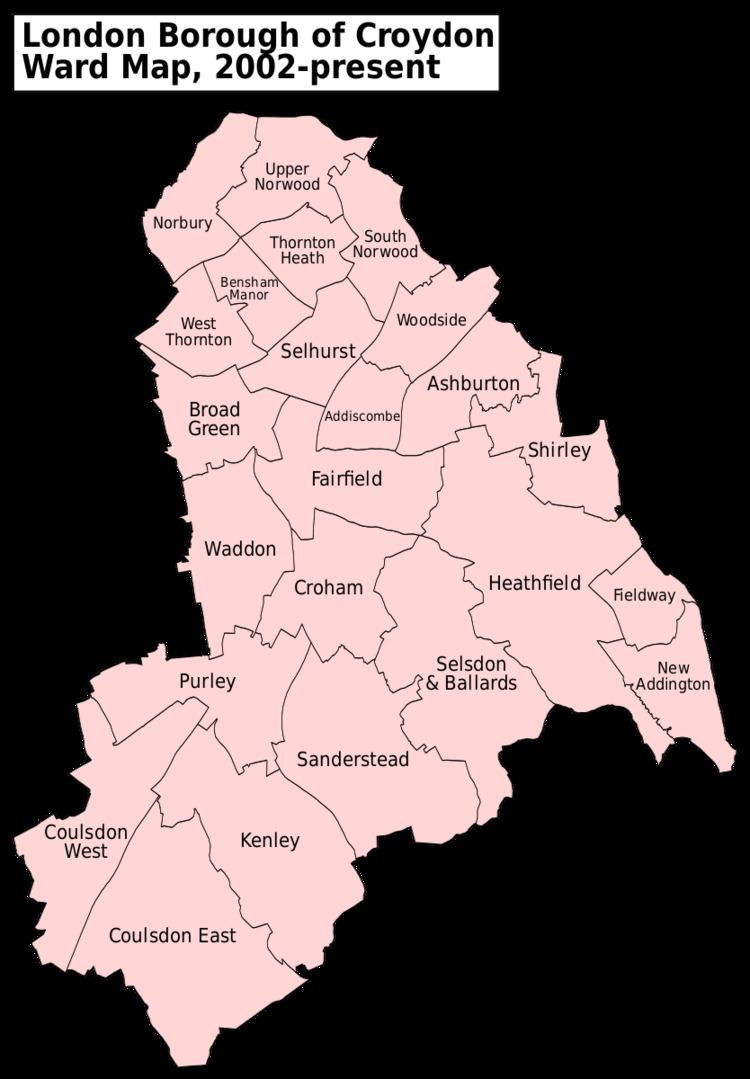 | ||
Elections for the Council in the London Borough of Croydon are held every four years to elect 70 councillors. At the last elections, which were held in May 2014, 30 Conservative councillors and 40 Labour councillors, providing a Labour majority of ten seats.
Contents
- Political control
- Leaders of the council
- Council elections
- Councillors by party
- 1964 1968
- 1990 1994
- 1994 1998
- 1998 2002
- 2002 2006
- 2006 2010
- 2010 2014
- 2014 2018
- Wards
- References
At the 2002 local elections, 37 Labour councillors, 32 Conservative councillors and one Liberal Democrat councillor were elected, maintaining Labour control of the Council. Subsequently, one Conservative councillor defected to Labour, defected back to the Conservatives, became an independent and then a Liberal Democrat. Following the death of one Labour councillor and the resignation of two councillors, three by-elections were won by the incumbent party in each case. A 6% swing from Labour to Conservative was seen in the last two in the run-up to the 2006 elections. However, following the Conservatives' victory in 2006, a February 2007 by-election saw a large swing back to Labour.
In 2002, Labour held Croydon with a tiny majority of votes in its marginal wards - one councillor won by just eight votes - and it was inevitable that in the 2006 election the fight would be keenly fought and closely observed. In the end, the Conservatives won 43 seats on the Council, defeating the lone Liberal Democrat and taking ten Labour seats in Waddon, Addiscombe, South Norwood and Upper Norwood.
In 2010, Labour gained six seats (net) from the Conservatives, reducing the Conservative majority on the Council to four seats.
Political control
Summary of council election results:
Leaders of the council
Council elections
Councillors by party
The controlling and majority group in the borough is the Labour Party. Since the 2014 election the composition has been:
1964-1968
There were no by-elections.
1990-1994
The by-election was called following the resignation of Cllr. Susan T. Taylor.
The by-election was called following the resignation of Cllr. David L. Congdon.
The by-election was called following the death of Cllr. John D. P. Yaxley.
The by-election was called following the resignation of Cllr. Anthony J. Slatcher.
The by-election was called following the resignation of Cllr. Ann A. Allan.
1994-1998
The by-election was called following the resignation of Cllr. Sherwan H. Chowdhury.
The by-election was called following the death of Cllr. Bruce T. H. Marshall.
The by-election was called following the resignation of Cllr. Alison J. Roberts.
The by-election was called following the resignation of Cllr. Geraint R. Davies.
1998-2002
The by-election was called following the resignation of Cllr. Louisa P. Woodley.
The by-election was called following the resignation of Cllr. Valerie Shawcross.
2002-2006
The by-election was called following the resignation of Cllr. Alexander Burridge.
The by-election was called following the death of Cllr. Mary M. Walker.
The by-election was called following the resignation of Cllr. Audrey-Marie M. Yates.
2006-2010
The by-election was called following the resignation of Cllr. Paula M. Shaw.
The by-election was called following the death of Cllr. Jonathan M. Driver.
2010-2014
There were no by-elections.
2014-2018
The by-election was triggered by the resignation of Councillor Emily Benn to pursue a job in New York City, United States
Wards
There are 24 wards which represent Croydon Council. All Croydon Council seats were up for re-election for the first time since the 2002 elections, during the election on 4 May 2006. Previously Labour held control of the council. In the election, the Conservatives took 10 seats from Labour and one from the Liberal Democrats. Since the election, Cllr Mike Mogul defected from Labour to the Conservatives adding another Conservative councillor, whilst Cllr Enley Taylor left the Conservative Group and Cllr Jonathan Driver, the Mayor at the time, died.
In the 2010 elections Labour gained six seats from the Conservatives, giving the council's political composition as:
